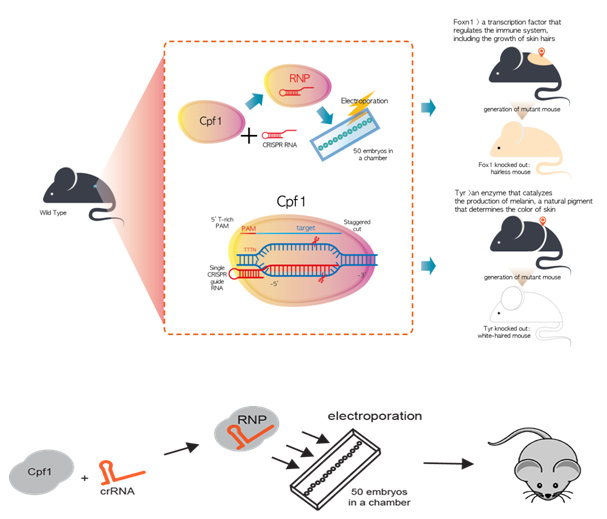CRISPR/Cpf1 Edits Mice Embryos Without Off-Target Effects


Source: IBS
Researchers at the IBS Center for Genome Editing in South Korea have successfully created mutant mice using CRISPR/Cpf1. The alternative to the well-known CRISPR/Cas9 system can edit genomes with exquisite precision and is highly programmable. The findings -published in two papers that appeared this month in the journal Nature Biotechnology-, together with previously known advantages of Cpf1 over Cas9, will probably convince many scientists to use also Cpf1 as an editing tool.
Based on the bacterial immune system CRISPR/Cas, Dr. Charpentier and Dr. Doudna developed the greatest recent discovery in the life sciences: the CRISPR genome editing tool. Basically, a guide RNA (gRNA) can be engineered to match the desired genomic sequence. gRNA binds the endonuclease Cas9 and transports it to the homologous sequence, which is processed by the protein. More recently, Broad Institute Researchers at MIT discovered CRISPR/Cpf1, a tool that presents several advantages over CRISPR/Cas9. Cpf1 only needs one mature crRNA to guide it to the target; it is smaller than Cas9, thus facilitating cell delivery; it cleaves pre-crRNA, so less molecules are needed in the RNA maturation process; and it performs a staggered cleavage pattern that facilitates genome editing.
Testing Cpf1 performance in vitro and in vivo
The team led by Jin-Soo Kim decided to test the efficiency of this new and promising editing tool. The researchers performed a Digenome-seq experiment with the Cpf1 families AsCpf1 and LbCpf1, determining in vitro on-target and off-target editing events in genomic DNA from humans. The results showed that both Cpf1 proteins had a >10-fold specificity than Cas9.
The researchers transfected Cpf1 RNPs into cells instead of delivering plasmids with Cpf1 and crRNA sequences. In this way, Cpf1 edits the target sequences immediately and is degraded quickly by endogenous mechanisms, avoiding off-target effects.
The team led by HUR K Junho went further and introduced Cpf1 RNPs into mouse embryos. The researchers targeted two genes that control hair growth and skin color, and these genes were successfully knocked out in 64% and 33% of the cases respectively. The mutant embryos were introduced into surrogate mothers, resulting in hairless and white-haired mice, as expected. Whole genome and targeted deep sequencing experiments revealed no off-target mutations.
CRISPR/Cpf1 is a very specific genome editing tool, in many ways superior to CRISPR/Cas9. We expect to see an increase of applications for Cpf1 and more research groups adopting it as their reference editing instrument.
Source: IBS
